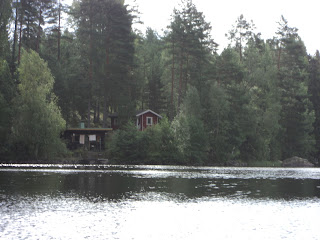Joyce Ashton was a friend of my
parents, in fact her daughter Joan was the vicar at mine and Janne's wedding.
Joyce was a good cook and an excellent cake maker and I always remember loving
this moist chocolate cake that she used to make. She gave us the recipe and it
was only recently when I was digging around the cookbooks at my Mum's that I
came across this recipe again and was reminded just how yummy this chocolate
cake is.
 It's not too chocolaty, which is
great. The sponge is quite light but then I like to make it a little bit
naughty by making a nice chocolate icing to go on top. You can make it however
you like: as a sandwich cake, a loaf cake or as cupcakes. Here I've made it as
cupcakes but if you want to do it as a sandwich cake just grease and line two
sandwich tins and make enough icing to go in the middle and on the top of the
cake.
It's not too chocolaty, which is
great. The sponge is quite light but then I like to make it a little bit
naughty by making a nice chocolate icing to go on top. You can make it however
you like: as a sandwich cake, a loaf cake or as cupcakes. Here I've made it as
cupcakes but if you want to do it as a sandwich cake just grease and line two
sandwich tins and make enough icing to go in the middle and on the top of the
cake.
For the cupcakes you will need
muffin cases, muffin tin, piping bag and two nozzles one thin and one star
nozzle.
Ingredients
for the sponge
-
6ozs/175g soft margarine
-
8ozs/225g self raising flour
-
1 1/2 level teaspoons of baking
powder
-
6ozs/175g caster sugar
-
3 eggs
-
3 tablespoons of milk
-
3 1/2 tablespoons of cocoa blended
with 3 1/2 tablespoons of hot water (cooled slightly) If the mixture is too
stiff add a little more milk to loosen but don't make it too runny.
Preheat the oven to gas mark 4 or
180c
Put all of the ingredients apart
from the eggs into a large mixing bowl. Beat the eggs and gradually add them to
the mixture to make sure that it doesn't curdle. Beat together for two minutes.
Fill the muffin tray with the muffin
cases and spoon mixture into each case (about two thirds full). Bake in the
preheated oven for about 25 minutes or until the sponge springs back and a
cocktail stick inserted into the middle comes out clean.
If you are making a sandwich cake
cook a bit longer for about 35 minutes.
Cool on a wire rack before icing.
To
make the icing and filling
-
2 1/2 ozs/ 60g of butter
-
1 1/2 tbsp of cocoa powder
-
9oz/250g of sieved icing sugar
-
3 tbsp of hot milk
-
1tsp of vanilla essence
Put the hot milk on the stove to
heat
In a separate pan melt the margarine
blending in the cocoa powder and then carefully stir in the icing sugar, hot
milk and essence.
Beat until smooth and thick.
If you are making a sandwich cake
spread the mixture into the middle of the cake. If you are making cupcakes you
can attach the small nozzle to your piping bag, spoon the mixture into the bag
and insert the nozzle into the middle of each cake and pipe the filling into
the middle.
For the icing make the mixture again
as above but add an extra 2-3ozs of sieved icing sugar to the mixture and beat
in until smooth and thick. You may need to chill in the fridge for a bit but
keep stirring every now again. This time either spread on to the top of your
sandwich cake or attach the star nozzle to your piping bag and fill with the
icing. Pipe onto your cupcake in a circular motion.
 Decorate your cupcakes or sandwich
cake with white chocolate shavings, mini eggs or even glitter - be as creative
as you wish!
Decorate your cupcakes or sandwich
cake with white chocolate shavings, mini eggs or even glitter - be as creative
as you wish!
These are delicious and the way to
any chocolate lovers heart. My two year old nephew(and my biggest cake critic) blew
off a doughnut in favour of a chocolate cupcake...and that's the biggest
compliment I can receive!





























